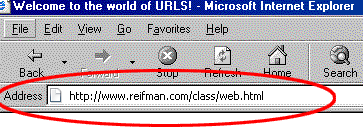The web is one part of the Internet, along with email, ftp, gopher, and other services. The web is based on hypertext which is a system for displaying information. Although initially just for text, now you can see many forms of media: graphics, animations, video, sound.
HTML stands for Hyper Text Mark-up Language, the way the information is coded so that it can be viewed on the web. HTML is made up of links which allow users to move through information in a variety of ways, so that each user can create a unique experience.
HTML is continually changing and evolving. Check out the World Wide Web Consortium , for the latest information on current HTML and web standards. There are many sites on the web which offer tutorials and reference guides, and a good web designer checks favorites frequently for information and new developments.
A browser is a piece of software with which you view the information available on the web. It transfers the information through the protocol of the Web, called HTTP , Hyper Text Transfer Protocol, and the language of the web, HTML. There are many different browsers: Microsoft's Internet Explorer, Mozilla's Firefox, the Mac Safari, Opera, and more.
Each browser is different and displays the information slightly differently. Also many still use older browsers on their machines, some of which cannot read graphics at all.
 The URL (Universal Resource Locator)is the address of the information for a particular web site. You type the url in your browser, which then connects to it.
Look at this interactive demonstration.
The URL (Universal Resource Locator)is the address of the information for a particular web site. You type the url in your browser, which then connects to it.
Look at this interactive demonstration.
File Names
File names are very important. All types of computers are connected via the Internet, and each have different rules. It is important to follow the most restrictive conventions. File names must:
- have no spaces in them
- never use any punctuation marks other than "-" or "_"
- be 8 letters or less
- all lower case
- have a dot and an appropriate 3 or 4 letter file extension, such as ".gif", ".html"
- includes the correct path name to take you to the actual file and folder (or directory) where it resides. This is very important to learn how to do: a page called "myfile.html" that is in a folder called "fileholder" would be called by naming both the path AND the file: "fileholder/myfile.html" .
Think you've got it? Well check this out.
back to syllabus
